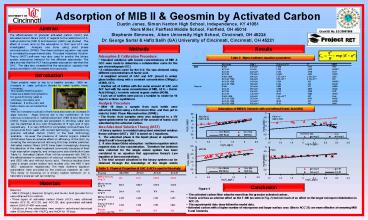Adsorption of MIB II - PowerPoint PPT Presentation
1 / 1
Title:
Adsorption of MIB II
Description:
The effectiveness of granular activated carbon (GAC) and activated carbon fibers ... GEO were made to determine a collaboration curve for the gas chromatograph (GC) ... – PowerPoint PPT presentation
Number of Views:307
Avg rating:3.0/5.0
Title: Adsorption of MIB II
1
Adsorption of MIB II Geosmin by Activated Carbon
Dustin Jones, Simon Kenton High School,
Independence, KY 41051 Nora Miller, Fairfield
Middle School, Fairfield, OH 45014 Stephanie
Simmons, Aiken University High School,
Cincinnati, OH 45224
Abstract
Grant ID No. EEC0601960
The effectiveness of granular activated carbon
(GAC) and activated carbon fibers (ACF) in
regards to the adsorption of 2-methyl-isobornel
(MIB II) and Geosmin (GEO) was studied The
effect of humic acid on the adsorption in GAC and
ACF was investigated. Analysis was done using
solid phase microextraction (SPME). The Myers
isotherm equation was used to correlate the
experimental data. The Ideal Adsorbed Solution
Theory (IAST) software was also used to predict
the binary system adsorption behavior for the
different adsorbents. The data showed that the
ACF had a greater adsorption rate than the GAC.
The data also revealed that the adsorption
capacity had direct correlation with increased
microporosity.
Dr. George Sorial Hafiz Salih (GA) University
of Cincinnati, Cincinnati, OH 45221
Results
Methods
- Adsorption Calibration Procedure
- Standard solutions with known concentrations of
MIB GEO were made to determine a collaboration
curve for the gas chromatograph (GC) - A collaboration curve for the U.V. Vis was
obtained using different concentrations of humic
acid. - A weighted amount of GAC and ACF placed in
amber glass bottles along with a constant
concentration (200µg/L) of MIB, GEO. - Another set of bottles with the same amount of
GAC and ACF had with the same concentration of
MIB, GEO, Humic Acid (45mg/L) to mimic natural
organic matter (NOM). - Each set of bottles were put on a tumbler to
rotate for 10 days to achieve equilibrium.
Table 2 Myers Isotherm equation parameters
Introduction
Clean potable water is key to a healthy society.
With an increase in water pollution threats to
water quality have increased.
One quality that the public notes as a
determining factors for good drinking water is
odorless, colorless, and tasteless. It is the
odor and taste where we will center this study.
- Analysis Procedure
- After 10 days a sample from each bottle were
extracted, filtered using a 0.45 micron filter,
and then put in vials for Solid Phase
Microextraction (SPME). - The Humic Acid samples were also subjected to a
UV spectrophotometer for analysis of the amount
of humic acid adsorbed by the activated carbon. - Idea Adsorbed Solution Theory (IAST)
- A binary system is modeled using ideal adsorbed
solution theory software (IAST). IAST is based
on 3 equations. - 1. The adsorbed phase the liquid phase at
equilibrium obey Raoults law equation. - 2. It also obeys Gibbs adsorption isotherm
equation which requires data at low
concentration. Therefore the isotherm data
collected for the single solute system has been
correlated to an equation that approaches Henrys
Law equation at low concentrations. - 3. The total amount adsorbed in the binary system
can be obtained through the knowledge of the
single solute isotherm
Adsorption of MIBII Geosmin with and without
Humic Acid (HA)
With an increase in pollution there have also
been an increase in algal blooms. Algal blooms
are a key contributor of two odorous compounds 2-
methylisoborneol (MIB II) and Geosmin (GEO).
These compounds are persistent in drinking water
and can be identified at low odor thresholds of 5
ng/L and 9 ng/L respectively. It is very
difficult to completely remove these two
compounds from water with current technology.
Adsorption by granular activated carbon (GAC) is
the best technology available. However the
presence of natural organic material (NOM) does
have an adverse effect on efficiency of the GAC,
by covering the micropores not allowing it to
trap smaller particles. Activated carbon fibers
(ACF) have been increasingly drawing the
attention of the water treatment community
because of their high adsorption capacity, and
unique pore size distribution (see Table 1).
Activated Carbon Fiber will be compared with GAC
in the effectiveness in adsorption of odorous
molecules like MIB II and GEO with and without
humic acid. Previous studies done used a single
solute system and studied only the MIB II and GEO
adsorption respectively. The Myer isotherm
equation parameters were provided by the previous
research as well. This study is focusing on a
binary system behavior on a laboratory scale as
well as modeling.
F-400 w/ humic acid
ACC-25 w/ humic acid
ACC-25
Table 1 Physical Properties of GAC ACFs used
in this study
Materials
Conclusion
Figure 1
- Materials
- MIB II (10mg/L), Geosmin (2mg/L), and Humic
Acid (powder form) were obtained from Aldrich. - Three types of activated carbon fibers (ACF)
were obtained namely ACC-15, ACC-20, and ACC-25,
also granulated activated carbon (GAC) F-400 were
used. - Solutions of the adsorbates were made in
autoclaved deionized water (DI) buffered with
KH2PO4 and NaOH for 10 days.
- The activated carbon fiber adsorbs more than
the granular activated carbon . - Humic acid has an adverse affect on the F-400
(as seen in Fig. 2) but not much of an affect on
the larger micropore distribution in - ACC-25.
- The experimental data does follow the model
data. - Activated carbon with a higher number of
micropores and larger surface area (like in
ACC-25) are more effective at removing MIB - II and Geosmin.































